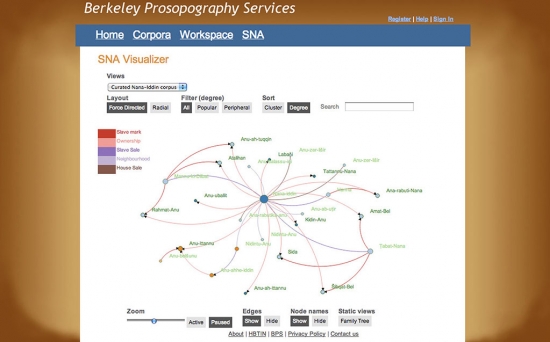Berkeley Prosopography Services (BPS) is a digital tool kit that supports the disambiguation of namesakes in text corpora, computes social network metrics, and generates interactive visualizations of those networks. Within the framework of the Social Science Matrix Prospecting Seminars, BPS is developing new research partners, both on and off campus. BPS project co-director Laurie Pearce (Near Eastern Studies) and technical lead Patrick Schmitz (Research IT) invited team members from diverse projects to explore collaborations that would extend the utility of BPS and support existing and developing research: UCB-based or affiliated projects Center for the Tebtunis Papyri (CTP: director, Prof. Todd Hickey, Michael Zellman-Rohrer, Micaela Langellotti), the SNAC project (UCB affiliates, Prof. Ray Larson, Rachael Hu, Yiming Liu), BPS software developer Davide Semenzin; external projects: Perseids (Bridget Almas, Tufts), Trismegistos (Prof. Mark Depauw, Katholieke Universiteit, Leuven) Coptic Scriptorium (Prof. Carrie Schroeder, University of the Pacific), and The Old Assyrian Social Network 1950-1750 BCE (Adam Anderson, Harvard).
In the face-to-face conversations that have taken place in three of four planned workshops (our final workshop is on Dec. 12), we have built a collegial environment by sharing the stories of our projects, the challenges as well as the successes. It has been particularly rewarding to explore how teams on projects at different stages of development think about a particular technical or humanities workflow issue.
One topic that impacts all of the projects is the construction of URIs/URNs. BPS provides tools that support probabilistic disambiguation of namesakes, in a workflow that emulates the researcher’s natural research agenda and which allows for the exploration of “what if” scenarios---including or excluding name citations as part of the support for a particular person-identification. Thus, the potential that an identifier might be assigned to a disambiguation that may change is a real, and challenging, possibility. The other projects face their own needs for developing URIs/URNs. In the Coptic Scriptorium, a digital text project focused on the markup of Coptic texts important for the early history of Christianity, a concern is the association of the text source with the identifications of persons and places in each text. To insure the ability to correctly disambiguate and identify named entities in the texts, project director Carrie Schroeder has consulted with Perseids staff member Bridget Almas on the forms URIs and URNs might assume. In the processing of its own well-established datasets, the CTP staff is exploring how to generate and preserve URIs they generate, as their data is integrated into the Trismegistos project, which presents a challenge as they assign merged identifiers. It is clear that we all have interdependencies, and these conversations provide us with a broader understanding of the implications of those connections.
The commitment of all participants to contribute data to group scrutiny and analysis speaks to the increasing recognition that digital humanities research projects do not, and can not, stand in isolation. Understanding each others’ specific concerns and rehearsing actual and potential resolutions strengthens our individual projects and the collaborations we expect to emerge.
The BPS team of Pearce, Schmitz, and co-director Niek Veldhuis (Near Eastern Studies) acknowledges the importance of the support of the Matrix seminars in identifying partners for ongoing development. The expansion of our network of research partners especially complements the refinement and integration of the BPS components that will occur in the next development cycle, supported by a NEH Digital Humanities Implementation Grant (2014-2016).
